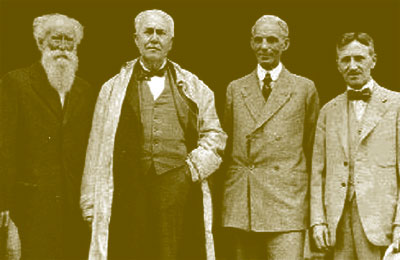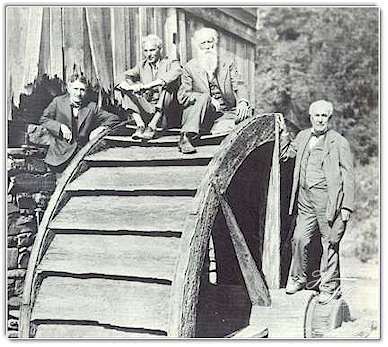A Memorial Service is Held for John Burroughs at Camp Harding
By
Francis Champ Zumbrun
“The woods will get you if you don’t watch out…Stay out close
to nature and you won’t want to come back to the civilizing influences of
trolley cars, telephones, porcelain bathtubs and nickel plumbing.” - Thomas
Edison at Muddy Creek, MD July 1921

John Burroughs, Thomas Edison,
Henry Ford and Harvey Firestone
The general public read with great interest the articles that
appeared in newspapers across the country reporting the camping adventures of
the vagabonds in western Maryland. The Maryland newspapers included photographs
showing the famous men participating in various outdoor activities with
President Harding, from relaxing in canvas-backed wooden folding chairs to
horseback riding.
One photograph captured Edison napping comfortably on the bare
ground. Soon after that photograph was taken, President Harding gently put a
newspaper over Edison’s face and smiled at child looking on in the crowd and
said, “we can’t let the gnats eat him up, now can we?”
After returning to the campsite from a horseback ride, the men
went fishing for about 30 minutes in Licking Creek, catching nothing. Edison was
overheard saying,” I don’t believe there ever were any fish in this creek.”
A local music dealer from Hagerstown made arrangements for a
player piano to be at the campsite. After dinner, the camping party danced to
popular music on a small wooden platform. Afterwards they sat around the
campfire in a large circle listening to Thomas Edison tell tall-tales.
Despite the presence of the President, an informal atmosphere
prevailed around the campfire. President Harding seemed to really enjoy himself.
Edison and Ford addressed Harding as “Mr. President,” while the Chief Executive
addressed the vagabonds by their first names. Ford, Edison and the President
were the last to leave the campfire, staying up to about two a.m. before
retiring and spending “a night under the canvas.”
On Sunday, July 24th, the camping party started stirring about
6:30 am. A breakfast was served followed by another short fifteen minute horse
ride.

On an ancient waterwheel in West Virginia in 1918, the
Four Vagabonds pose for a cameraman.
Left to right are Harvey Firestone, Henry Ford, John Burroughs and
Thomas A. Edison.
A Sunday memorial service followed, dedicated to memory of John
Burroughs, the famous nature writer and naturalist who passed away earlier that
year. This was their first campout without him since they started camping. The
vagabonds deeply missed the company of their friend.
Hundreds of people were present at the service, coming from
nearby farms and communities to see and meet the famous men. Bishop Anderson, a
Methodist minister from Ohio and friend of Firestone, presided over the
service. The Bishop began the service reminding everyone that the forest was
God’s first temple. Mrs. Firestone played several hymns on the piano that were
appropriate to the memory of Burroughs, including “Rock of Ages,” and “Nearer My
God to Thee.”
“Rock of Ages” hinted of Burroughs’ interest for rocks and
geology, a topic he often wrote about. The verse in the hymn, “when I soar to
worlds unknown,” reminded everyone of Burroughs love for birds.
“Nearer My God to Thee” was inspired from an Old Testament
biblical story about Jacob. Night had overtaken Jacob while he was traveling
through the wilderness. As darkness descended, Jacob was forced to set up camp
and sleep under the stars, using a rock for his pillow. Jacob awoke with a new
revelation. Refreshed and renewed the next morning, and surrounded by the beauty
of the great outdoors, Jacob was inspired to proclaim, “This is an awesome
place!” Coincidently, as I was writing this article, I heard a Florida visitor
repeat the same words about Green Ridge State Forest, “This is an awesome
place”- a sentiment certainly shared by the vagabonds at times on their campouts
over the years.
The verses from the popular hymn, “like a bird on joyful wings”
flying under the “sky, sun, moon, and stars,” reminded the vagabonds of
auto-touring around the country with Burroughs like carefree birds to the grand
places of nature.
The camping adventures of the vagabonds spurred great interest
in outdoor recreation and a demand for public land for motor-touring and
camping. In 1921, only 4,000 acres of state “forest reserves” existed in
Maryland. Today, Maryland enjoys close to 500,000 acres of public land. The
publicity following the vagabonds helped to bring about public support to
acquire additional land for public parks and forests across the country.
Acknowledgements:
Maryland State Forester Francis Champ Zumbrun, author,
is the retired Manager of Green Ridge State Forest.
This is the third part of an occasional series about Thomas Edison,
Henry Ford and Harvey Firestone’s travels to Western Maryland,
originally published in the Cumberland Times News.
Back to Travelers Page